| View previous topic :: View next topic |
| Author |
Message |
Kara
Joined: 22 Jul 2018
Posts: 120


|
 Posted: Sep 07, 2018 04:07 Post subject: Tourmaline type question Posted: Sep 07, 2018 04:07 Post subject: Tourmaline type question |
|
|
I have trouble naming these tourmalines found from Viitaniemi and Haapaluoma Finland.
Please help me:
1) pics 1a / b / c: What is the name of a green and pink tourmaline with the colours in opposite order than in the watermelon-type?
2) pic 2a. There are two shades of green in there, is it all verdelite?
The rest of the pics are all verdelite, I think.
Thank you! Kara
| Locality: | | Haapaluoma pegmatite, Seinäjoki, Seinäjoki municipality, Southern Ostrobothnia, Finland |  |
|
| Description: |
|
| Viewed: |
31202 Time(s) |
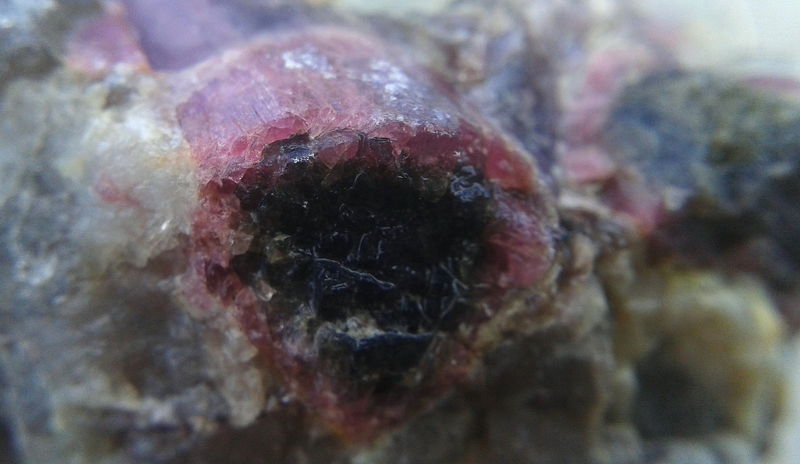
|
| Locality: | | Haapaluoma pegmatite, Seinäjoki, Seinäjoki municipality, Southern Ostrobothnia, Finland |  |
|
| Description: |
|
| Viewed: |
31176 Time(s) |
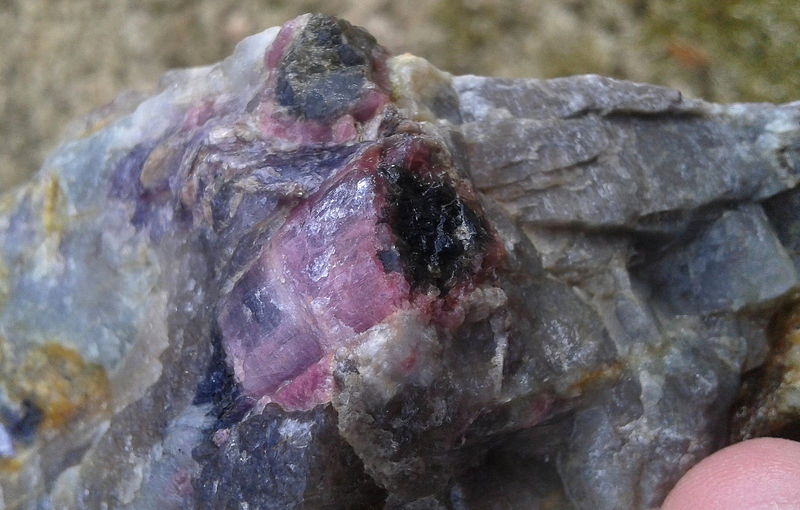
|
| Locality: | | Haapaluoma pegmatite, Seinäjoki, Seinäjoki municipality, Southern Ostrobothnia, Finland |  |
|
| Description: |
|
| Viewed: |
31186 Time(s) |
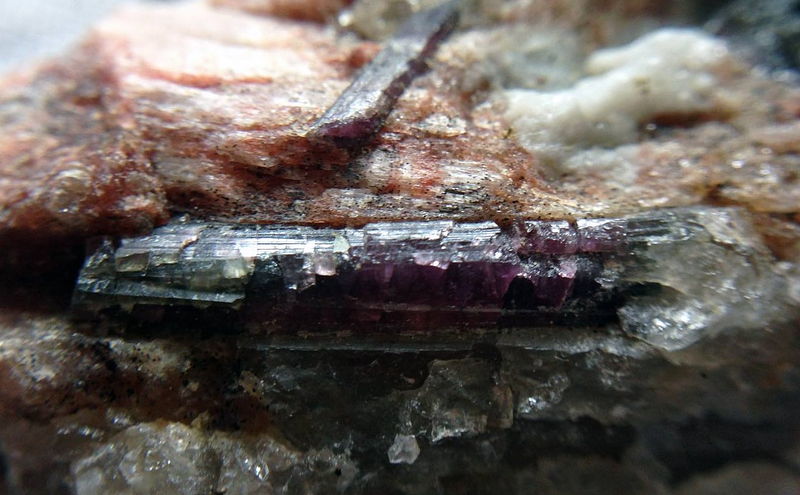
|
| Locality: | | Viitaniemi pegmatite, Eräjärvi, Orivesi, Tampere, Pirkanmaa, Finland |  |
|
| Description: |
|
| Viewed: |
31199 Time(s) |
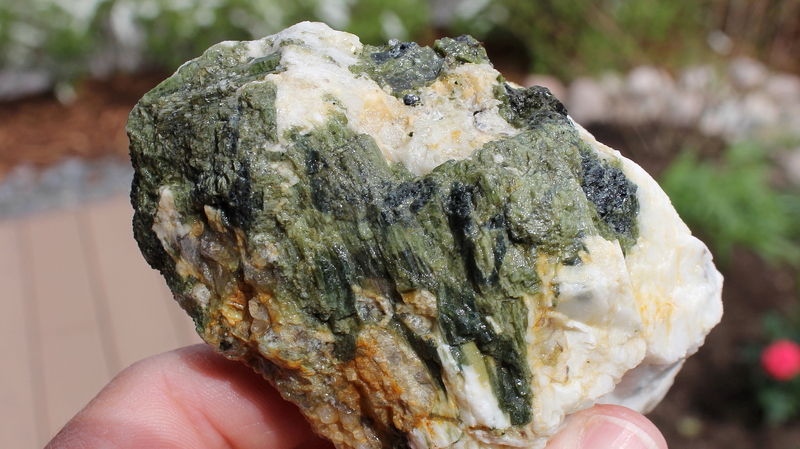
|
| Locality: | | Viitaniemi pegmatite, Eräjärvi, Orivesi, Tampere, Pirkanmaa, Finland |  |
|
| Description: |
|
| Viewed: |
31244 Time(s) |
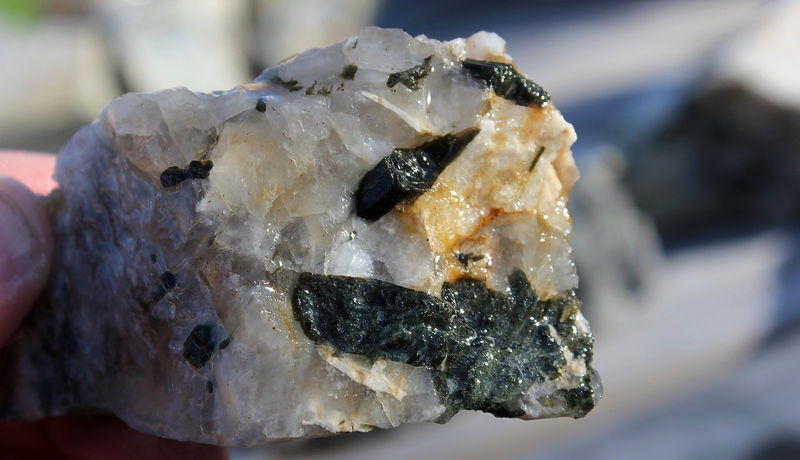
|
| Locality: | | Viitaniemi pegmatite, Eräjärvi, Orivesi, Tampere, Pirkanmaa, Finland |  |
|
| Description: |
|
| Viewed: |
31225 Time(s) |
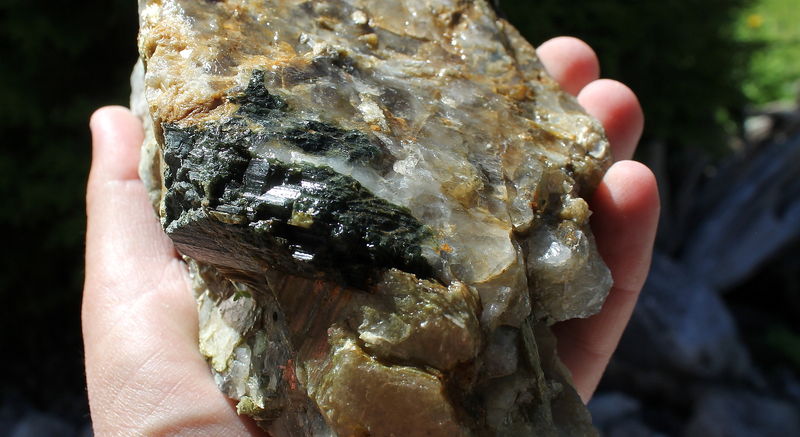
|
| Locality: | | Viitaniemi pegmatite, Eräjärvi, Orivesi, Tampere, Pirkanmaa, Finland |  |
|
| Description: |
|
| Viewed: |
31208 Time(s) |
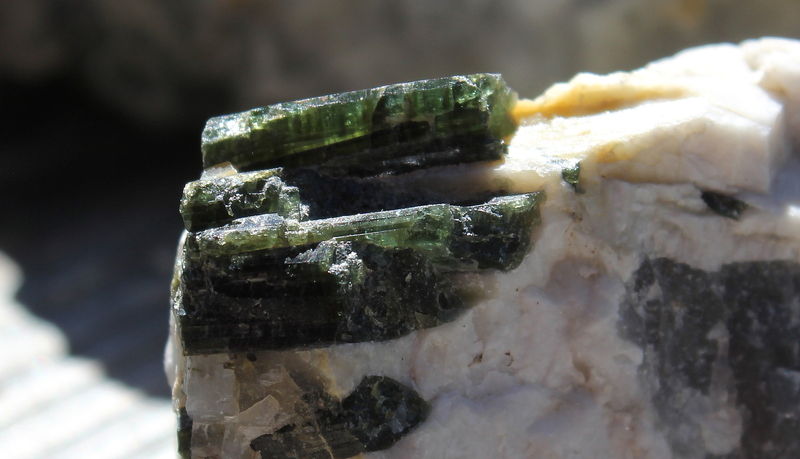
|
|
|
| Back to top |
|
 |
Peter Lemkin
Joined: 18 Nov 2016
Posts: 403
Location: Prague


|
 Posted: Sep 07, 2018 05:50 Post subject: Re: Tourmaline type question Posted: Sep 07, 2018 05:50 Post subject: Re: Tourmaline type question |
|
|
My, my, my....for the amateur you claim to be, you certainly find some very interesting crystals and minerals. The reddish tourmaline is what I believe is usually called rubellite - and those are certainly from a VERY interesting pegmatite!!! They look like very good quality and 'poking' around them, one might find top notch specimens. Is that pegmatite being worked, or were these pieces that had just fallen off on their own - hard to believe someone would have knocked them off the main pegmatite and left them on the ground. The green ones are called, as you said, verdelite. I'd suggest you look on mindat(.)org for these and if you want filter for Finland or the pegmatite you mentioned. When a crystal of this type starts to let light through and is hard and not shattered you have a nice specimen. The best specimens usually are found inside of pockets within such pegmatites along with other nice crystals of different types. One can learn how to 'read' a pegmatite to make an intelligent guess as to where the pockets might be...if you are REALLY LUCKY and at a pegmatite others have not explored, you might rarely even see a part of a pocket exposed - but that is truly a rare find.
There are more named subtypes of tourmaline than on this little chart.....
| Description: |
|
| Viewed: |
31248 Time(s) |
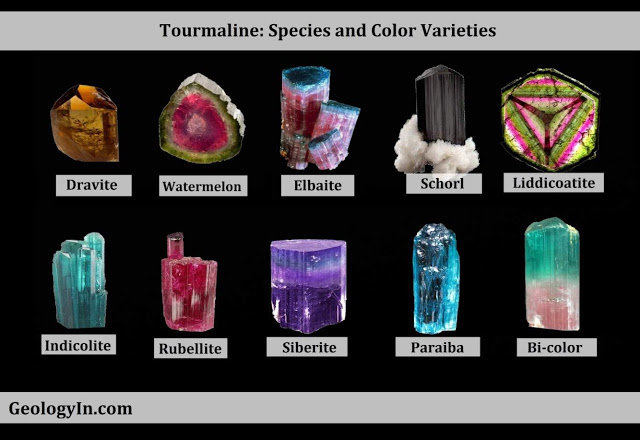
|
|
|
| Back to top |
|
 |
Tobi
Site Admin
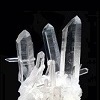
Joined: 07 Apr 2009
Posts: 4235
Location: Germany



|
 Posted: Sep 07, 2018 06:24 Post subject: Re: Tourmaline type question Posted: Sep 07, 2018 06:24 Post subject: Re: Tourmaline type question |
|
|
| There's often a lot of chaos around "correct" naming of minerals. I think it should not be wrong if you call the pink one rubellite and the green ones verdelite, as you already did ...
|
|
| Back to top |
|
 |
Kara
Joined: 22 Jul 2018
Posts: 120


|
 Posted: Sep 07, 2018 06:43 Post subject: Re: Tourmaline type question Posted: Sep 07, 2018 06:43 Post subject: Re: Tourmaline type question |
|
|
Thank you Tobi and Peter again. You are so kind to help.
Peter yes I am a novice in this rock hobby when it comes to identifying minerals and rocks, for I have gotten the interest on hunting minerals only a couple of years ago. I am a biologist with no studies on minerals. I have collected lots and lots of rocks for fun and to show the kids when teaching at upper secondary school. My problem is, I have had no time to really study mineral identification, and only now I have the time to check the rocks I have found over the years. I can identify the basic rocks and some basic minerals, but thats it. I have an enormous appetite for information, and am learning a lot here, thanks to the educative answers I get at this forum. I really appreciate all of your help.
Both of the places I have found these coloured tourmalines, are old closed pegmatite quarries mined for feldspar. Lots of different minerals can still be found from the dump material left there. I have found also some beautiful blue topaz and other minerals with persistent digging. If you are interested in these kind of pegmatites, here is some information of the Viitaniemi pegmatite minerals:
https://tupa.gtk.fi/julkaisu/bulletin/bt_314.pdf
(link normalized by FMF)
I have studied Mindat pages of the quarries and checked the photo albums. Maybe due to the strange classification of tourmalines, there are photos of the same types but some of them are named elbaite, some rubellite. I think both verdelite and rubellite are elbaite types, is this correct?
I have found also small rubellites, but they are all unicolor. I am wondering if the two-coloured tourmalines be called rubellites too? The core is green and the outer layer pink.
| Locality: | | Haapaluoma pegmatite, Seinäjoki, Seinäjoki municipality, Southern Ostrobothnia, Finland |  |
|
| Description: |
|
| Viewed: |
31181 Time(s) |
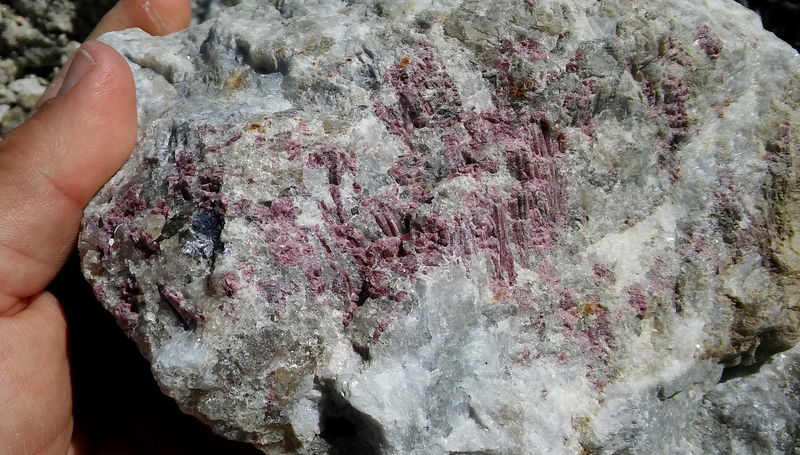
|
|
|
| Back to top |
|
 |
Tobi
Site Admin

Joined: 07 Apr 2009
Posts: 4235
Location: Germany



|
 Posted: Sep 07, 2018 06:54 Post subject: Re: Tourmaline type question Posted: Sep 07, 2018 06:54 Post subject: Re: Tourmaline type question |
|
|
| Kara wrote: | | I have found also small rubellites, but they are all unicolor. I am wondering can the two-coloured tourmalines be called rubellites too? |
I'm not sure ... in case of doubt, call them elbaite, this includes both rubellites and multi-coloured ones ;-)
|
|
| Back to top |
|
 |
Peter Lemkin
Joined: 18 Nov 2016
Posts: 403
Location: Prague


|
 Posted: Sep 07, 2018 07:44 Post subject: Re: Tourmaline type question Posted: Sep 07, 2018 07:44 Post subject: Re: Tourmaline type question |
|
|
| Looking in my book by Wilke on Mineral Hunting in Scandinavia, he lists [among others] verdellite and rubellite (up to 10cm!), lepidolite mica, spodumene (up to 10 cm), beryl, spessartine garnet, cleavelandite, quartz, columbite, cassiterite, microline, xenotime, apatite, and several others.....so, digging into the dumps - or hunting to find if some parts of the pegmatite were not mined - might be worth your time if you go there again! Nearby are two other pegmatites at Kaatiala and Hunnakko with somewhat similar minerals. North of that area there are many other mineral collecting locations - not all pegmatites.
|
|
| Back to top |
|
 |
Jesse Fisher

Joined: 18 Mar 2009
Posts: 639
Location: San Francisco



|
 Posted: Sep 07, 2018 09:45 Post subject: Re: Tourmaline type question Posted: Sep 07, 2018 09:45 Post subject: Re: Tourmaline type question |
|
|
What you need to keep in mind is that the terms "rubellite," "indicolite," and "verdelite" are varietal names based solely on the color of the tourmaline. They are used in the gemstone business, but have no meaning in the mineralogical sense. "Tourmaline" is actually actually the name of a group of minerals related by chemistry and structure. The chemistry and structure of the tourmaline group is quite complex and many of the described species will take advanced scientific equipment to differentiate. As a rule of thumb, however, if the tourmaline comes from a granitic pegmatite, the colored varieties are likely to be elbaite, though if there is calcium available in the rock during crystallization, they could also be liddicoatite. This is rare, however, and liddicoatite is only known from a few locations world-wide. Black tourmaline found in granitic pegmatites is most likely schorl, though some others do exist. These are near impossible to identify in hand-specimen, so calling black tourmaline found in these rocks "schorl" is a safe bet.
In metamorphic rocks such as marbles, skarns and schists, uvite and dravite are the most common tourmalines. They are usually dark brown or black but can sometimes be found in greens and yellows. Again, differentiation requires chemical analysis, to determine the magnesium to calcium ratio in the crystal. Uvite is calcium-rich while dravite is magnesium-rich.
In a nutshell, however, if you are dealing with granitic rocks (which it looks like you are) the colored tourmaline is likely elbaite and the black is schorl.
|
|
| Back to top |
|
 |
Kara
Joined: 22 Jul 2018
Posts: 120


|
 Posted: Sep 07, 2018 10:03 Post subject: Re: Tourmaline type question Posted: Sep 07, 2018 10:03 Post subject: Re: Tourmaline type question |
|
|
Jesse thank you very very much for the information. This is very interesting, gives a whole new and deeper perspective for me to study my samples. Also very interesting to hear about the schist tourmalines, for I have been wondering about a schist area with crystals that look like tourmaline. The pictures are in my "crystal vein again"-post here at the forum.
Kara
|
|
| Back to top |
|
 |
Susan Robinson
Joined: 05 Aug 2010
Posts: 163
Location: Hancock, MI


|
 Posted: Sep 07, 2018 10:58 Post subject: Re: Tourmaline type question Posted: Sep 07, 2018 10:58 Post subject: Re: Tourmaline type question |
|
|
Jesse - you did a great job explaining the difference between tourmaline, species of tourmaline, and commonly-used varietal names. I hope the readers put this information to memory. The pegmatite looks like a good one that Kara is collecting tourmalines from. I wish we had something like that in St. Lawrence Co., NY!
_________________
Susan Robinson |
|
| Back to top |
|
 |
Riccardo Modanesi
Joined: 07 Nov 2011
Posts: 630
Location: Milano


|
 Posted: Sep 07, 2018 11:19 Post subject: Re: Tourmaline type question Posted: Sep 07, 2018 11:19 Post subject: Re: Tourmaline type question |
|
|
Hi to everybody, hi Kara!
I already saw the elbaites and schorlites from Viitaniemi and Haapaluoma, Pekka (you should know whom I'm talking about) offered me some nice specimens. RUbellite is actually the red variety of elbaite and verdelite the green one. If you see Mindat or the Glossary of MIneral Species, you can find the right nomenclature for this group as well as many other ones!
Greetings from Italy by Riccardo.
_________________
Hi! I'm a collector of minerals since 1973 and a gemmologist. On Summer I always visit mines and quarries all over Europe looking for minerals! Ok, there is time to tell you much much more! Greetings from Italy by Riccardo. |
|
| Back to top |
|
 |
Jordi Fabre
Overall coordinator of the Forum

Joined: 07 Aug 2006
Posts: 5026
Location: Barcelona



|
 Posted: Sep 07, 2018 14:56 Post subject: Re: Tourmaline type question Posted: Sep 07, 2018 14:56 Post subject: Re: Tourmaline type question |
|
|
| Susan Robinson wrote: | | The pegmatite looks like a good one that Kara is collecting tourmalines from. I wish we had something like that in St. Lawrence Co., NY! |
Kara (and everybody ;-) I'm sure you will enjoy this so much: New find of minerals from New York
|
|
| Back to top |
|
 |
jorge santos garcia
Joined: 06 Jan 2008
Posts: 34
Location: Évora



|
 Posted: Sep 07, 2018 17:37 Post subject: Re: Tourmaline type question Posted: Sep 07, 2018 17:37 Post subject: Re: Tourmaline type question |
|
|
Hello Kara (and all)
We shall avoid the use of varietal/commercial tourmaline names such as verdelite, rubellite, indicolite, schorl, etc., as they do not mean anything more than the color of the specimen, rather than the tourmaline's species.
Varietal names may only be used when dealing with faceted gemstones, as in this case the species is not a criterion for setting its price, but color is, as you can see in any jewelry store.
Unfortunately, even scientific people/museums do this error, as we can see on the post "Another trip to the Marburg Museum" (pictures IMG_2098.JPG or IMG_2049.JPG).
If the bibliography of the pegmatite (the article you posted or other) identifies the tourmaline's species or if you or someone had it identified, you can name it accordingly - elbaite, liddicoatite (these two being the most plausible hipothesis), uvite, schorl, dravite, etc.. If not, call it simply tourmaline.
Jorge
|
|
| Back to top |
|
 |
Kara
Joined: 22 Jul 2018
Posts: 120


|
 Posted: Sep 08, 2018 02:01 Post subject: Re: Tourmaline type question Posted: Sep 08, 2018 02:01 Post subject: Re: Tourmaline type question |
|
|
Riccardo yes I think I know who you mean. I haven't met him in person, but I know he is the most respected mineral man in this area.
Jordi the link you gave is superb! My heart just stopped pounding when I saw the pictures. Some of them look very much like my backyard rock. Now I really have to start studying it.
Peter I did a quick visit to those near quarries a little while ago, but there were not much to find at the time (I think there had been lots of hobbyists digging this summer). I found only a small piece of red tourmaline and some lepidolite mica. Few years ago I found some apatite and a spodumene too, and some minerals I can'tidentify.
And thank you all for the information on tourmaline naming. I prefer the real mineralogical names.
Kara
|
|
| Back to top |
|
 |
Carles Millan
Site Admin
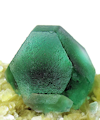
Joined: 05 May 2007
Posts: 1531
Location: Catalonia



|
 Posted: Sep 08, 2018 15:29 Post subject: Re: Tourmaline type question Posted: Sep 08, 2018 15:29 Post subject: Re: Tourmaline type question |
|
|
| jorge santos garcia wrote: | | If not, call it simply tourmaline. |
The venerable Dr. Frederick Pough said something like "Just call it tourmaline. Tourmaline is a perfectly good name. You don't need 15 new names for the same mineral. That is just dumb!". Cited by our beloved Rock Currier in his excellent text "About Mineral Collecting", The Mineralogical Record. Nowadays many people label elbaite without even being sure it is. Me too.
|
|
| Back to top |
|
 |
Peter Lemkin
Joined: 18 Nov 2016
Posts: 403
Location: Prague


|
 Posted: Sep 09, 2018 00:29 Post subject: Re: Tourmaline type question Posted: Sep 09, 2018 00:29 Post subject: Re: Tourmaline type question |
|
|
| What Pough and others say is true/correct. Each to their own on this. On my mineral labels, I put Tourmaline (var. xxxxx) and leave it at that. I know the variety is not an approved separate mineral in and of itself - but by color they are <commonly> referred to differently - and even then only with very sophisticated tests can one even know if, how much, and with what minor elements the chemical formula differs - or what is actually causing the color change.
|
|
| Back to top |
|
 |
|





